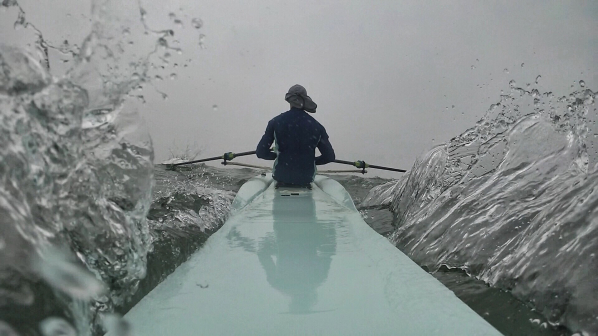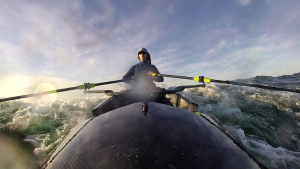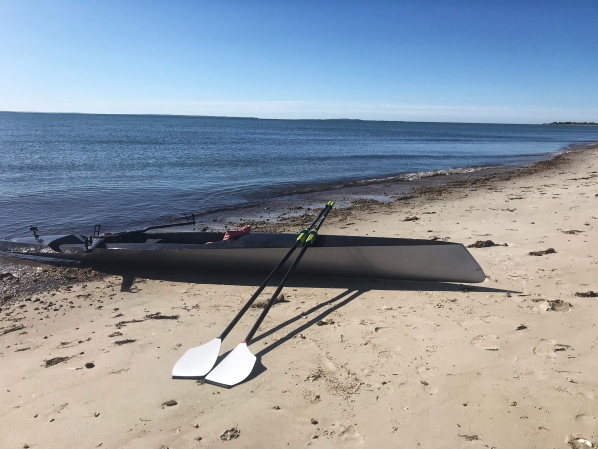Oars for Every Boat: Coastal Rowing

The growing sport of coastal rowing adds splashes of excitement—literally—to traditional flat-water rowing. Using competitive self-bailing coastal boats, the sport is rowed on oceans and coastal waters where surf and tides test athlete speed on varying conditions.
World Rowing coastal rowing features singles, doubles, mixed doubles and coxed quads. While the event’s Olympic debut has been delayed until the 2028 Summer Olympics, World Rowing has hosted coastal World Championships since 2007. Coastal rowing has been around for centuries; racing in the United States is relatively new. Athletes such as Ben Booth, the first US athlete to compete in the World Rowing Coastal Championships (2015), are training and experimenting with equipment for the different disciplines of coastal rowing, which includes beach starts (2k and sprint racing) and longer endurance races. Booth competed for the US in the 2018 World Rowing Coastal Championships and has his eyes set on Los Angeles 2028.
For coastal rowing, oars needs to be both durable and agile. Rowers may catch crabs, roll or collide with other boats. Concept2 sculls are custom-built and are suitable for coastal rowing; we can build what coastal rowers need.
Options
Booth has tested different set-ups, including exploring blade options for efficiency and feel. His preferred blade designs are the Smoothie2 Vortex and the Comp.
Many newcomers to the sport find the versatile and often familiar Smoothie2 Vortex blade as a great fit: it's neat and efficient at the catch and its curvature helps with depth control. The vortex edge adds efficiency and can protect the blade tip.
The Comp blade is proving to be a popular option for athletes in both flatwater and coastal rowing; in larger coastal boats, its responsiveness and liveliness balances changing conditions. Booth recommends the Comp for intermediate to more advanced athletes in moderate wave conditions.
Comp: At the Catch
Booth finds the Comp blade a “lively” fit for coastal boats. “Coastal boats are heavy and are rowed in a ‘heavy’ environment,” he explains, “where there is often a lot of wind and waves that can stall the boat—it is not uncommon to go from a full clip to a near standstill as a breaking wave crashes into and fills up the boat. You want a solid feeling at the catch, but not a heavy one.”
In his ideal, “you need a certain softness mixed in at the catch, something that won’t jar the body with a suddenly too heavy load.” The Comp is proving a fit. “I think the Comp does a good job at this. While it catches solidly, it is not heavy. The flex of the Skinny shaft I think helps this. I like the cushion it provides in this initial moment of the stroke,” says Booth.
Comp: The Drive in Choppy Water

On the drive, Booth describes the Comp as stable. “I found when moving the boat through choppy water the blades were unaffected and allowed me to hang off them comfortably. Once in the water, they stay there, locked in well. This is a really good feature of the Comp. It’s light, but very stable. Stability is an absolute necessity in coastal rowing.”
Comp: Higher Stroke Rates
Booth reports an ease with rowing at higher stroke rates with the Comp blade. This is a characteristic we’ve heard about from athletes using the Comps on flatwater, too. As Booth explains, “the speed of the finish and turnaround at the hands allows the stroke rate to climb without any conscious effort. This is good for coastal racing. In the endurance format, being able to keep up a high cadence for 20-30 minutes is key. In the Beach Sprints, the entire race is only 500 meters across the water.”
 The Concept2 team is happy to discuss oar options with you, whether for coastal rowing, open water rowing, skiffs, wherries, guide boats, dories or other rowing shells
The Concept2 team is happy to discuss oar options with you, whether for coastal rowing, open water rowing, skiffs, wherries, guide boats, dories or other rowing shells
